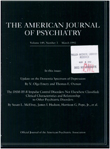The prevalence of posttraumatic stress disorder and its clinical significance among Southeast Asian refugees
Abstract
All 322 patients at a psychiatric clinic for Indochinese refugees were surveyed to determine the presence of posttraumatic stress disorder (PTSD). If PTSD was not diagnosed at the time of initial evaluation, a structured reinterview was performed. Seventy percent of the patients (N = 226) met the criteria for a current diagnosis of PTSD, and an additional 5% (N = 15) met the criteria for a past diagnosis. The Mein had the highest rate of PTSD (93%) and the Vietnamese the lowest (54%). Of the patients with PTSD who were enrolled in the clinic before March 1988, 46% (N = 87) were given a diagnosis of PTSD only after the reinterview. PTSD is a common disorder among Indochinese refugees, but the diagnosis is often difficult to make.
Access content
To read the fulltext, please use one of the options below to sign in or purchase access.- Personal login
- Institutional Login
- Sign in via OpenAthens
- Register for access
-
Please login/register if you wish to pair your device and check access availability.
Not a subscriber?
PsychiatryOnline subscription options offer access to the DSM-5 library, books, journals, CME, and patient resources. This all-in-one virtual library provides psychiatrists and mental health professionals with key resources for diagnosis, treatment, research, and professional development.
Need more help? PsychiatryOnline Customer Service may be reached by emailing [email protected] or by calling 800-368-5777 (in the U.S.) or 703-907-7322 (outside the U.S.).



